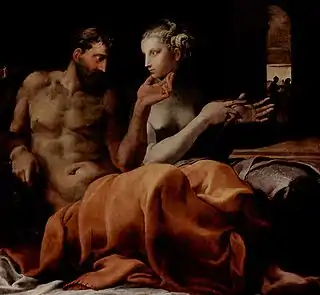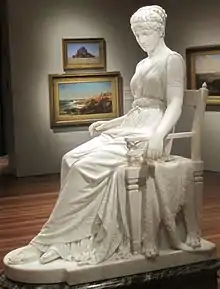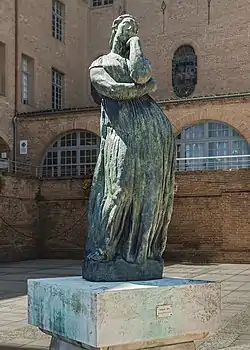Penelope
Penelope (/pəˈnɛləpiː/ pə-NEL-ə-pee; Greek: Πηνελόπεια, Pēnelópeia, or Greek: Πηνελόπη, Pēnelópē) is a character in Homer's Odyssey. Her name is traditionally associated with marital fidelity, as she is known for her fidelity to Odysseus, to whom she is married, despite having many suitors while he was absent.

Etymology
Glossed by Hesychius as "some kind of bird"[1] (today arbitrarily identified with the Eurasian wigeon, to which Linnaeus gave the binomial Anas penelope), where -elōps (-έλωψ) is a common Pre-Greek suffix for predatory animals;[2] however, the semantic relation between the proper name and the gloss is not clear. In folk etymology, Pēnelopē (Πηνελόπη) is usually understood to combine the Greek word pēnē (πήνη), "weft", and ōps (ὤψ), "face", which is considered the most appropriate for a cunning weaver whose motivation is hard to decipher.[3] Robert S. P. Beekes believed the name to be Pre-Greek and related to pēnelops (πηνέλοψ)[4] or pēnelōps (πηνέλωψ).
Role in the Odyssey
Penelope is married to the main character, the king of Ithaca, Odysseus (Ulysses in Roman mythology), and daughter of Icarius of Sparta and Periboea (or Polycaste). She only has one son with Odysseus, Telemachus, who was born just before Odysseus was called to fight in the Trojan War. She waits twenty years for Odysseus' final return,[5] during which time she devises various strategies to delay marrying any of the 108[6] suitors (led by Antinous and including Agelaus, Amphinomus, Ctessippus, Demoptolemus, Elatus, Euryades, Eurymachus and Peisandros).
On Odysseus's return, disguised as an old beggar, he finds that Penelope has remained faithful. She has devised tricks to delay the suitors, one of which is to pretend to be weaving a burial shroud for Odysseus's elderly father Laertes and claiming that she will choose a suitor when she has finished. Every night for three years, she undoes part of the shroud, until Melantho, a slave, discovers her chicanery and reveals it to the suitors.[7]

Because of her efforts to put off remarriage, Penelope is often seen as a symbol of marital fidelity.[8] But because Athena wants her "to show herself to the wooers, that she might set their hearts a-flutter and win greater honor from her husband and her son than heretofore", Penelope does eventually appear before the suitors (xviii.160–162). As Irene de Jong comments:
As so often, it is Athena who takes the initiative in giving the story a new direction ... Usually the motives of mortal and god coincide, here they do not: Athena wants Penelope to fan the Suitors’ desire for her and (thereby) make her more esteemed by her husband and son; Penelope has no real motive ... she simply feels an unprecedented impulse to meet the men she so loathes ... adding that she might take this opportunity to talk to Telemachus (which she will indeed do).[9]

She is ambivalent, variously asking Artemis to kill her and, apparently, considering marrying one of the suitors. When the disguised Odysseus returns, she announces in her long interview with the disguised hero that whoever can string Odysseus's rigid bow and shoot an arrow through twelve axe heads may have her hand. "For the plot of the Odyssey, of course, her decision is the turning point, the move that makes possible the long-predicted triumph of the returning hero".[10]
There is debate as to whether Penelope is aware that Odysseus is behind the disguise. Penelope and the suitors know that Odysseus (were he in fact present) would easily surpass them all in any test of masculine skill, so she may have intentionally started the contest as an opportunity for him to reveal his identity. On the other hand, because Odysseus seems to be the only person (perhaps excepting Telemachus) who can actually use the bow, she could just be further delaying her marriage to one of the suitors.[11]
When the contest of the bow begins, none of the suitors are able to string the bow, except Odysseus who wins the contest. Having done so, he proceeds to slaughter the suitors—beginning with Antinous whom he finds drinking from his cup—with help from Telemachus, Athena and two slaves, Eumaeus the swineherd and Philoetius the cowherd. Odysseus has now revealed himself in all his glory (with a little makeover by Athena); yet Penelope cannot believe that her husband has really returned—she fears that it is perhaps some god in disguise, as in the story of Alcmene—and tests him by ordering her slave Eurycleia to move the bed in their bridal-chamber. Odysseus protests that this cannot be done since he made the bed himself and knows that one of its legs is a living olive tree. Penelope finally accepts that he truly is Odysseus, a moment that highlights their homophrosýnē (ὁμοφροσύνη, "like-mindedness").[12] Homer implies that from then on Odysseus would live a long and happy life together with Penelope and Telemachus, wisely ruling his kingdom and enjoying wide respect and much success.[13]
In some early sources such as Pindar, Pan's parents are Apollo and Penelope.[14] Herodotus (2.145), Cicero (ND 3.22.56), Apollodorus (7.38) and Hyginus (Fabulae 224) all describe Hermes and Penelope as his parents. Pausanias 8.12.5 records the story that Penelope had in fact been unfaithful to Odysseus, who banished her to Mantineia upon his return. 5th-century AD source Dionysiaca by Nonnus (14.92) names Penelope of Mantineia in Arcadia Pan's mother. Other sources (Duris of Samos; the Vergilian commentator Servius) report that Penelope had sex with all 108 suitors in Odysseus' absence, and gave birth to Pan as a result.[15] This myth reflects the folk etymology that equates Pan's name (Πάν) with the Greek word for "all" (πᾶν).[16]
Iconography

Penelope is recognizable in Greek and Roman works, from Attic vase-paintings—the Penelope Painter is recognized by his representations of her—to Roman sculptures copying or improvising upon classical Greek models, by her seated pose, by her reflective gesture of leaning her cheek on her hand, and by her protectively crossed knees, reflecting her long chastity in Odysseus' absence, an unusual pose in any other figure.[17]
Latin tradition
Latin references to Penelope revolved around her sexual loyalty to the absent Odysseus. It suited the marital aspect of Roman society representing the tranquility of the worthy family.[18] She is mentioned by various classical authors including Plautus,[19] Propertius,[20] Horace, Ovid, Martial and Statius. The use of Penelope in Latin texts provided a basis for her ongoing use in the Middle Ages and Renaissance as a representation of a chaste wife. This was reinforced by her being named by Saint Jerome among pagan women famed for their chastity.
Notes
- Γλῶσσαι.
- Zeno.org lemma relating πηνέλωψ (gen. πηνέλοπος) and <χην(ά)λοπες>· ὄρνεα (predators) ποιά. ὅπερ ἔνιοι <χηναλώπεκες>.
- For the mythology of weaving, see Weaving (mythology).
- R. S. P. Beekes (2009). Etymological Dictionary of Greek. Brill. p. 1186.
- Odysseus spends ten years in the Trojan War and ten years travelling home.
- Homer. The Odyssey, Book XVI, in The Iliad & The Odyssey. Trans. Samuel Butler. p. 628. ISBN 978-1-4351-1043-4
- St. Clair, Kassia (2018). The Golden Thread: How Fabric Changed History. London: John Murray. pp. 11–12. ISBN 978-1-4736-5903-2. OCLC 1057250632.
- J.W. Mackail, Penelope in the Odyssey (Cambridge University Press, 1916)
- Irene de Jong. (2001). A Narratological commentary on the Odyssey, p. 445. Cambridge University Press, ISBN 0-521-46844-2
- Bernard Knox. (1996). Introduction to Robert Fagles's translation of The Odyssey p. 55.
- Reece, Steve, "Penelope's ‘Early Recognition’ of Odysseus from a Neoanalytic and Oral Perspective," College Literature 38.2 (2011) 101-117. Penelopes Early Recognition of Odysseus
- Austin, Norman (1975). Archery at the Dark of the Moon: Poetic Problems in Homer's Odyssey. Berkeley: University of California Press. p. 231.
- Lawall, Thalman, Patterson, James, Spacks. "The Norton Anthology: Western Literature."The Odyssey". New York, London. 1984.
- Pindar, Fr. 90 (Bowra)
- Footnote in the Library by Apollodorus (of Athens), edited by E. Capps Ph.D, LL.D.; T. E. Page, Litt.D.; W. H. D. Rouse, Litt.d.; Webster Collection of Social Anthropology, p. 305
- The Homeric Hymn to Pan provides the earliest example of this wordplay, suggesting that Pan's name was born from the fact that he delighted "all" the gods.
- But compare, for an unusual exception, the seated aulos player on the "Ludovisi Throne.
- Mactoux, Marie-Madeleine (1975). Pénélope: Légende et Mythe. Paris: Annales Litteraires de L'Universite de Basancon. pp. 129–30.
- Nixon, Paul (1968). Plautus. London: William Heinemann Ltd. She is mentioned in the opening lines of the play Stychus
- Propertius (2004). Complete Elegies of Propertius. Princeton and Oxford: Princeton University Press.see Elegies 2.6; 2.9 and 3.12. Propertius was one of the few Latin authors to mention Penelope's weaving ruse.
Sources
Primary sources
- Homer, Odyssey
- Ovid, Heroides I
- Lactantius Placidus, Commentarii in Statii Thebaida
Secondary sources
- Amory, Anne (1963), ‘The reunion of Odysseus and Penelope’, in Charles H. Taylor (ed.) Essays on the Odyssey: Selected Modern Criticism. Bloomington: Indiana University Press, pp. 100–36.
- Clayton, Barbara (2004), A Penelopean Poetics: Reweaving the Feminine in Homer’s Odyssey. Lanham, Maryland and Oxford: Lexington Books.
- Cohen, Beth (1995, ed.), The Distaff Side: Representing the Female in Homer’s Odyssey. New York and Oxford: Oxford University Press.
- Doherty, Lillian E. (1995), Siren Songs: Gender, Audiences, and Narrators in the Odyssey. Ann Arbor: University of Michigan Press.
- Felson, Nancy (1994). Regarding Penelope: From Character to Poetics. Princeton, NJ: Princeton University Press.
- Finley, M.I. The World of Odysseus, London. Pelican Books (1962).
- Hall, Edith (2008), The Return of Ulysses: A Cultural History of Homer’s Odyssey. London and New York: I. B. Tauris.
- Heilbrun, Carolyn G. (1991), ‘What was Penelope unweaving?’, in Heilbrun, Hamlet’s Mother and Other Women: Feminist Essays on Literature. London: The Women's Press, pp. 103–11.
- Heitman, Richard (2005), Taking her Seriously: Penelope and the Plot of Homer's Odyssey. Ann Arbor: Michigan University Press. ISBN 0-472-11489-1.
- Katz, Marylin Arthur (1991), Penelope’s Renown: Meaning and Indeterminacy in the Odyssey. Princeton: Princeton University Press.
- Marquardt, Patricia A. (1985), ‘Penelope “ΠΟΛΥΤΡΟΠΟΣ”’, American Journal of Philology 106, 32-48.
- Reece, Steve, "Penelope's ‘Early Recognition’ of Odysseus from a Neoanalytic and Oral Perspective," College Literature 38.2 (2011) 101-117. Penelopes_Early_Recognition_of_Odysseus
- Roisman, Hanna M. (1987), ‘Penelope’s indignation’, Transactions of the American Philological Association 117, 59-68.
- Schein, Seth L. (1996, ed.), Reading the Odyssey: Selected Interpretive Essays. Princeton: Princeton University Press. ISBN 0-691-04440-6
- Wohl, Victoria Josselyn (1993), ‘Standing by the stathmos: the creation of sexual ideology in the Odyssey’, Arethusa 26, 19-50.
- Zeitlin, Froma (1996). 'Figuring fidelity in Homer's Odyssey in Froma Zeitlin, Playing the Other: Gender and Society in Classical Greek Literature. Chicago: University of Chicago Press. pp. 19–52.
- Zerba, Michelle (2009), ‘What Penelope knew: doubt and scepticism in the Odyssey’, Classical Quarterly 59, 295-316.
External links
| Wikimedia Commons has media related to Penelope (mythology). |
| Wikisource has the text of the 1921 Collier's Encyclopedia article Penelope. |
- Odyssey in English on the Perseus Project
- Penelope Unravelling Her Web – a painting of Penelope by Joseph Wright of Derby (from the Getty Museum)
- Penelope and the Suitors, a painting by John William Waterhouse; explore other paintings depicting Penelope
